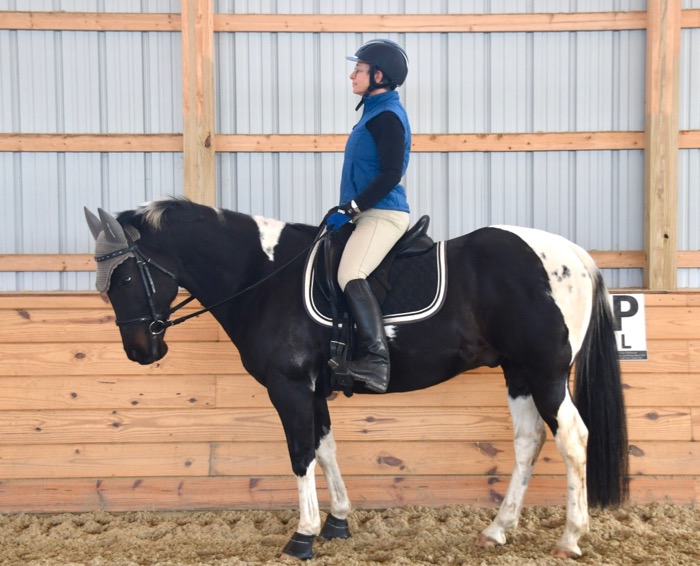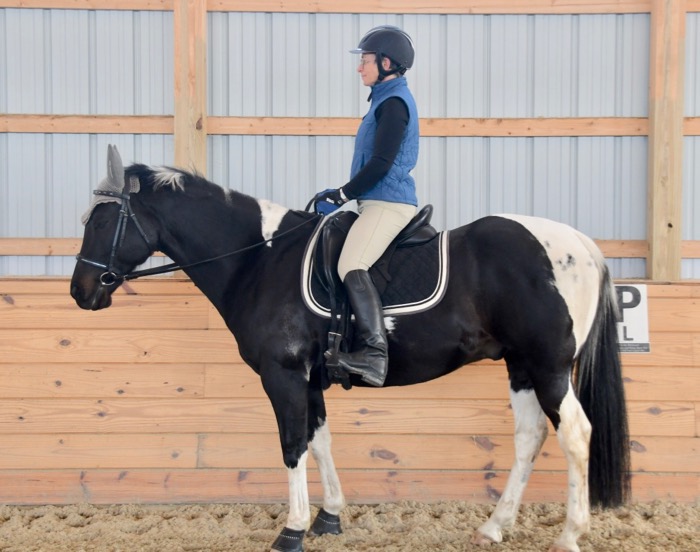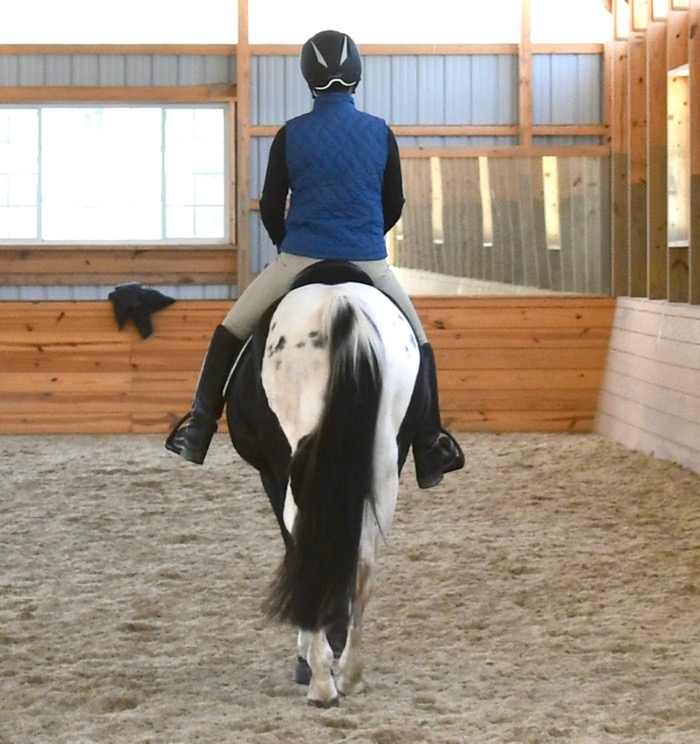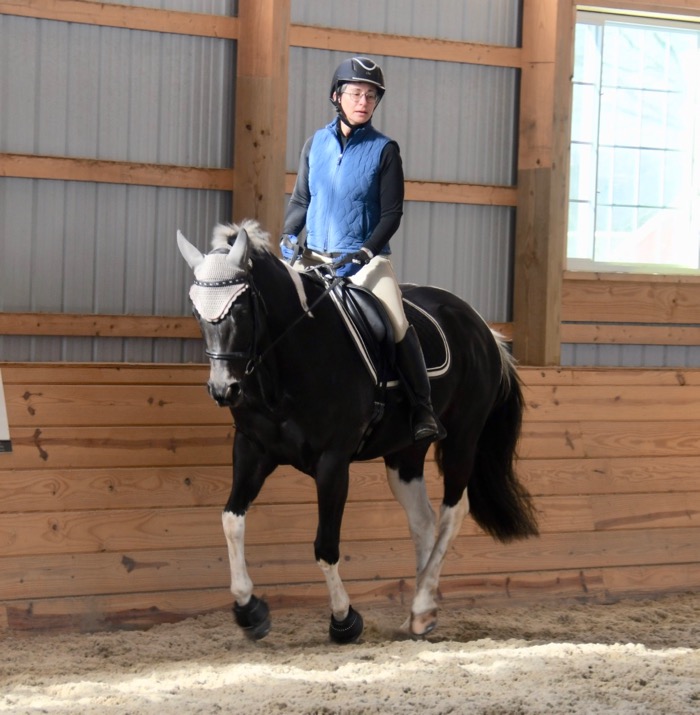The best trainers, the ones who successfully teach others to do challenging behaviors, do it in a way that gives the learner optimism and keeps them engaged. Frustration is rare and the sense of accomplishment is pervasive. This isn’t because the teacher is a cheerleader that says good job! irregardless of the performance. Rather, it’s that the trainer has broken down the task into the smallest of achievable steps, describes each exercise with clarity and brevity, and continuously increases criteria so that progress seems seamless but is observable.
At least, that’s what we try to do!
Riding is a very complex endeavor. It’s not enough to sit up straight and put your heels down. It’s also the weight in your sitting bones (and which one), whether the pinky is closed or open on the reins, how flexible your hip joint is, the depth of your breath, the tension in your forearm… The horse notices all of these nuances, and changes their way of going accordingly. When teaching, it’s most effective to mention only one of these things at a time before moving onto the next. Ideally, the rider alters their position in that moment, and then practices it, gaining body memory, so that it stays fixed. But learning to ride in the most effective position is rarely that linear.
That old song, Dem Bones, still rings true. Everything is connected.
I tend to round my shoulders.

If you tell me square my shoulders, my back arches. My elbows come too far back. My thighs tighten.

This is what brings me to my domino theory of riding instruction. Instead of fixing each piece of the rider’s position, I try to find the first domino that makes all of the others fall into place.
For example, someone who rides with their elbows jutting out can be told to bring them against their sides. But a few strides later, those elbows fly out again. I’ve found that the fix is not in the arms, but in the hands! I ask the rider to bring their thumbs up. This rotates the wrist and the lower arm, so that instead of forcing the elbows in, they naturally fall into place.
The solution to my round shoulders? I tell myself to pull belly button to back. That engages my core, lifts my sternum, drops the points of my shoulders, and gives me a flat back. It’s so much better to find that first domino than to try to fix each of those issues individually.

I recently wrote about looking where you’re going and how that can improve your riding. In a lesson last week, with my trainer Kim Litwinczak, she further finessed that for me and found my first domino. It turns out that along with being right or left-handed, we also have a dominant eye. Mine is my left. Even when I think I’m looking straight ahead, I’m actually gazing more to the left. Just doing that makes small but observable changes in my position. Look closely and you’ll see a slight collapse in my left rib cage, a drop in my left shoulder and a tilt to my head. That puts more weight on my right hip and foot. It’s subtle, but it causes Tonka to go unevenly.

My left gaze is much more obvious in this photo. Looking left even brings my left hand too low.

Kim could have harped on my collapsed side, my low hand, my tilted head. But she knew the domino. I was taking a lesson on my friend’s horse, Maggie. Kim said, Look over Maggie’s outside ear with your left eye.
Everything fell into place.
Do you have a first domino? Leave a comment!
Just for fun- here’s my favorite video of Maggie. This is a mare that loves her food and knows how to savor it. Here she is after one tiny cookie.


Many years ago, I was a member of a riding team that competed in local horse shows. We took it seriously, but toward the end of the season we would sometimes get silly and play pranks on each other. As I was waiting right outside the arena about to enter and compete, riding a very simple dressage program, my friend stepped up and dusted off my boots, wiped my mare down quickly with a barely damp rag, adjusted a few braids and wished me luck. What I hadn’t seen was her slipping my mare her very favorite treat, a giant mouthful of peanut butter. Picture me trotting around on a lovely black bay mare who was doing the exact same thing Maggie is doing in your video, above, the ENTIRE program. Not a thing I could do and the small crowd was hysterical. (Note: I did get her back….)
Oh Tracey! You can’t leave that hanging in the air!!! What did you do?!?
Hilarious and cringe-worthy at the same time.
Very informative post!! Maggie is very cute; reminds me of my horse.
Glad you liked the post. Maggie is a sweetheart.
Good post. I wish I would have read this years ago when I was teaching my nieces to ride in stead of always “heels down, shoulders square” etc. etc. They actually did go on to become good riders in spite of my teaching.
I find that thinking to pull in the belly button as you said does for me what it does for you. When I do that, it seems to get everything where it should be. So I guess that would be my first domino. Then getting my seat bones positioned properly would by the second domino. As you said, it becomes second nature after a while you do it without thinking about it.
Very helpful blog. Do you find it very different riding Maggie instead of Tonka, she looks a lot bigger? I love the video of Maggie savouring every last morsel of that cookie. I see its snowing again hope not to much this time. 🙂